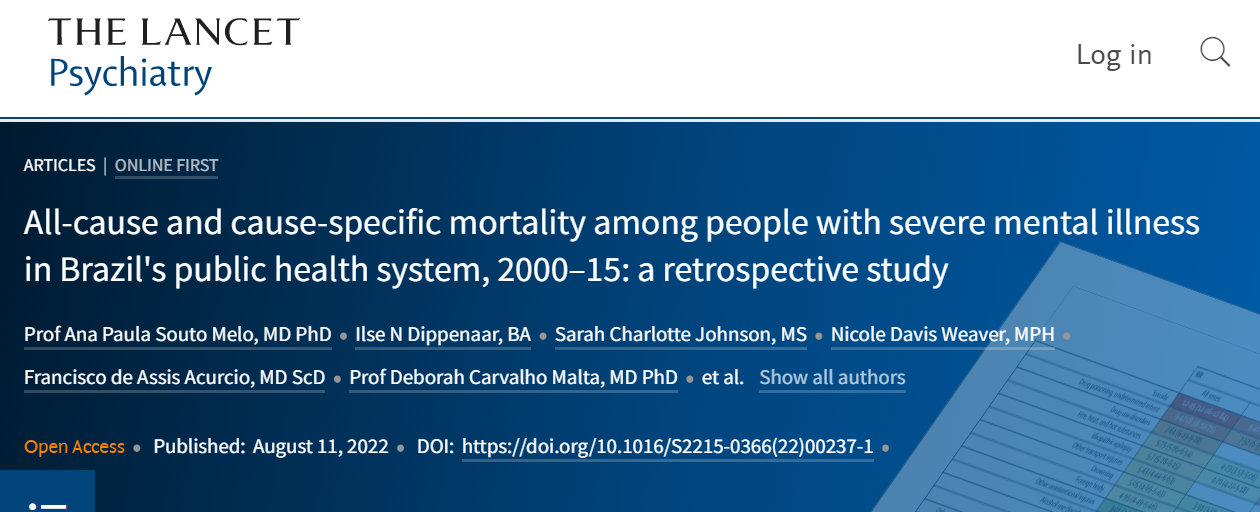IHME researchers and GBD collaborators published a new study in The Lancet Psychiatry on the mortality of patients with severe mental illness in Brazil.
IHME
August 16, 2022
This site version was edited by:
Joaquim Cardoso MSc.
The Health Institute — for health systems transformation (HST)
Mental Health Unit
August 16, 2022
Key messages:
- Among all patients hospitalized through the Brazilian Public Health System (Sistema Único de Saúde) from 2000 to 2015, the relative risk for death for inpatients who had severe mental illness was 1.27 times greater than that of inpatients without severe mental illness.
- By age group, younger people aged 15–29 had a higher relative risk for death.
- Injuries (suicide, interpersonal violence, and road injuries) and cardiovascular disease had the highest excess mortality rate among patients with severe mental illness.
- The study’s results suggest the need to remove barriers to integrating medical and mental health care for patients with severe mental illness, particularly for younger patients.
The study’s results suggest the need to remove barriers to integrating medical and mental health care for patients with severe mental illness, particularly for younger patients.
Introduction of the paper:
- Life expectancy among those with severe mental illness — including schizophrenia, bipolar and depressive disorders, and their related spectrum disorders — is 10–20 years shorter than the general population.
- Life expectancy for those with severe mental illness is around 15 years lower for women and 20 years lower for men compared with the general population.
- Excess mortality is not solely explained by the increased risk of death by suicide and other injuries; communicable and non-communicable diseases (NCDs) account for the majority of premature mortality.
- Among NCDs, cardiovascular disease is the leading preventable cause of early deaths in those with severe mental illness.
- Researchers have discussed the necessity of efforts to increase timely and effective health-care interventions, with the aim of reducing overall mortality in this vulnerable population.
- However, there have been various barriers to scaling up evidence-based care and improving the life expectancy of these patients, especially in Brazil, a middle-income country with low levels of investment in mental health.
Conclusion of the paper:
- In conclusion, this study shows that inpatients with severe mental disorders in Brazil have a higher risk of death compared with inpatients with other diagnoses, particularly from ischaemic heart disease.
- Beyond suicide prevention, interventions for many deaths caused by accidents, injuries, or homicides are urgently required, notably interpersonal violence.
- Young patients with mental disorders should be a priority group, considering that most causes of death observed in this age group in this study are preventable.
- Each psychiatric admission presents an opportunity for general medical assessment, enabling preventive health measures that can save lives.
- The results of this study indicate the need to remove barriers to the integration of medical and mental health care for patients with severe mental illness to reduce excess mortality.

ORIGINAL PUBLICATION

All-cause and cause-specific mortality among people with severe mental illness in Brazil’s public health system, 2000–15: a retrospective study
The Lancet — Psychiatry
Prof Ana Paula Souto Melo, MD PhD
Ilse N Dippenaar, BA
Sarah Charlotte Johnson, MS
Nicole Davis Weaver, MPH
Francisco de Assis Acurcio, MD ScD
Prof Deborah Carvalho Malta, MD PhD
Prof Antônio Luiz P Ribeiro, MD PhD
Augusto Afonso Guerra Júnior, MSc ScD
Eve E Wool, MPH
Prof Mohsen Naghavi, MD PhD
Prof Mariangela Leal Cherchiglia, MD PhD
August 11, 2022
SUMMARY
Background
- People with severe mental illness have a mortality rate higher than the general population, living an average of 10–20 years less.
- Most studies of mortality among people with severe mental illness have occurred in high-income countries (HICs).
- We aimed to estimate all-cause and cause-specific relative risk (RR) and excess mortality rate (EMR) in a nationwide cohort of inpatients with severe mental illness compared with inpatients without severe mental illness in a middle income country, Brazil.
Methods
- This national retrospective cohort study included all patients hospitalised through the Brazilian Public Health System (Sistema Único de Saúde [SUS]-Brazil) between Jan 1, 2000, and April 21, 2015.
- Probabilistic and deterministic record linkages integrated data from the Hospital Information System (Sistema de informações Hospitalares) and the National Mortality System (Sistema de Informação sobre Mortalidade).
- Follow-up duration was measured from the date of the patients’ first hospitalisation until their death, or until April 21, 2015.
- Severe mental illness was defined as schizophrenia, bipolar disorder, or depressive disorder by ICD-10 codes used for the admission.
- RR and EMR were calculated with 95% CIs, comparing mortality among patients with severe mental illness with those with other diagnoses for patients aged 15 years and older.
- We redistributed deaths using the Global Burden of Diseases, Injuries, and Risk Factors Study methodology if ill-defined causes of death were stated as an underlying cause.
Findings
- From Jan 1, 2000, to April 21, 2015, 72 021 918 patients (31 510 035 [43·8%] recorded as male and 40 974 426 [56·9%] recorded as female; mean age 41·1 (SD 23·8) years) were admitted to hospital, with 749 720 patients (372 458 [49·7%] recorded as male and 378 670 [50·5%] as female) with severe mental illness. 5 102 055 patient deaths (2 862 383 [56·1%] recorded as male and 2 314 781 [45·4%] as female) and 67 485 deaths in patients with severe mental illness (39 099 [57·9%] recorded as male and 28 534 [42·3%] as female) were registered.
- The RR for all-cause mortality in patients with severe mental illness was 1·27 (95% CI 1·27–1·28) and the EMR was 2·52 (2·44–2·61) compared with non-psychiatric inpatients during the follow-up period.
- The all-cause RR was higher for females and for younger age groups; however, EMR was higher in those aged 30–59 years.
- The RR and EMR varied across the leading causes of death, sex, and age groups.
- We identified injuries (suicide, interpersonal violence, and road injuries) and cardiovascular disease (ischaemic heart disease) as having the highest EMR among those with severe mental illness.
- Data on ethnicity were not available.
Interpretation
- In contrast to studies from HICs, inpatients with severe mental illness in Brazil had high RR for idiopathic epilepsy, tuberculosis, HIV, and acute hepatitis, and no significant difference in mortality from cancer compared with inpatients without severe mental illness.
- These identified causes should be addressed as a priority to maximise mortality prevention among people with severe mental illness, especially in a middle-income country like Brazil that has low investment in mental health.
Funding
Bill and Melinda Gates Foundation,
Fundação de Amparo a Pesquisa do Estado de Minas Gerais,
FAPEMIG, and the
Coordenação de Aperfeiçoamento de Pessoal de Nível Superior — Brasil.
Authors & affiliations:
Prof Ana Paula Souto Melo, MD PhD
Ilse N Dippenaar, BA
Sarah Charlotte Johnson, MS
Nicole Davis Weaver, MPH
Francisco de Assis Acurcio, MD ScD
Prof Deborah Carvalho Malta, MD PhD
Prof Antônio Luiz P Ribeiro, MD PhD
Augusto Afonso Guerra Júnior, MSc ScD
Eve E Wool, MPH
Prof Mohsen Naghavi, MD PhD
Prof Mariangela Leal Cherchiglia, MD PhD
Universidade Federal de São João Del Rei,
São João del-Rei, Brazil
(Prof A P S Melo MD PhD);
Universidade Federal de Minas Gerais, Belo Horizonte, Brazil
(Prof A P S Melo, F de Assis Acurcio MD ScD,
Prof D C Malta MD PhD,
A L P Ribeiro MD PhD,
A A Guerra Júnior MSc ScD,
Prof M L Cherchiglia MD PhD);
Institute for Health Metrics and Evaluation
(I N Dippenaar BA,
S C Johnson MS,
N Davis Weaver MPH,
E E Wool MPH,
Prof M Naghavi MD PhD) and
Department of Health Metrics Sciences
(Prof M Naghavi),
University of Washington, Seattle, WA, USA; Centro Colaborador do SUS para Avaliação de Tecnologias e Excelência em Saúde, Belo Horizonte, Brazil (F de Assis Acurcio,
A A Guerra Júnior);
Telehealth Center and Cardiology Service, Hospital das Clínicas, and Department of Internal Medicine,
Faculdade de Medicina, Belo Horizonte, Brazil
(Prof A L P Ribeiro)












